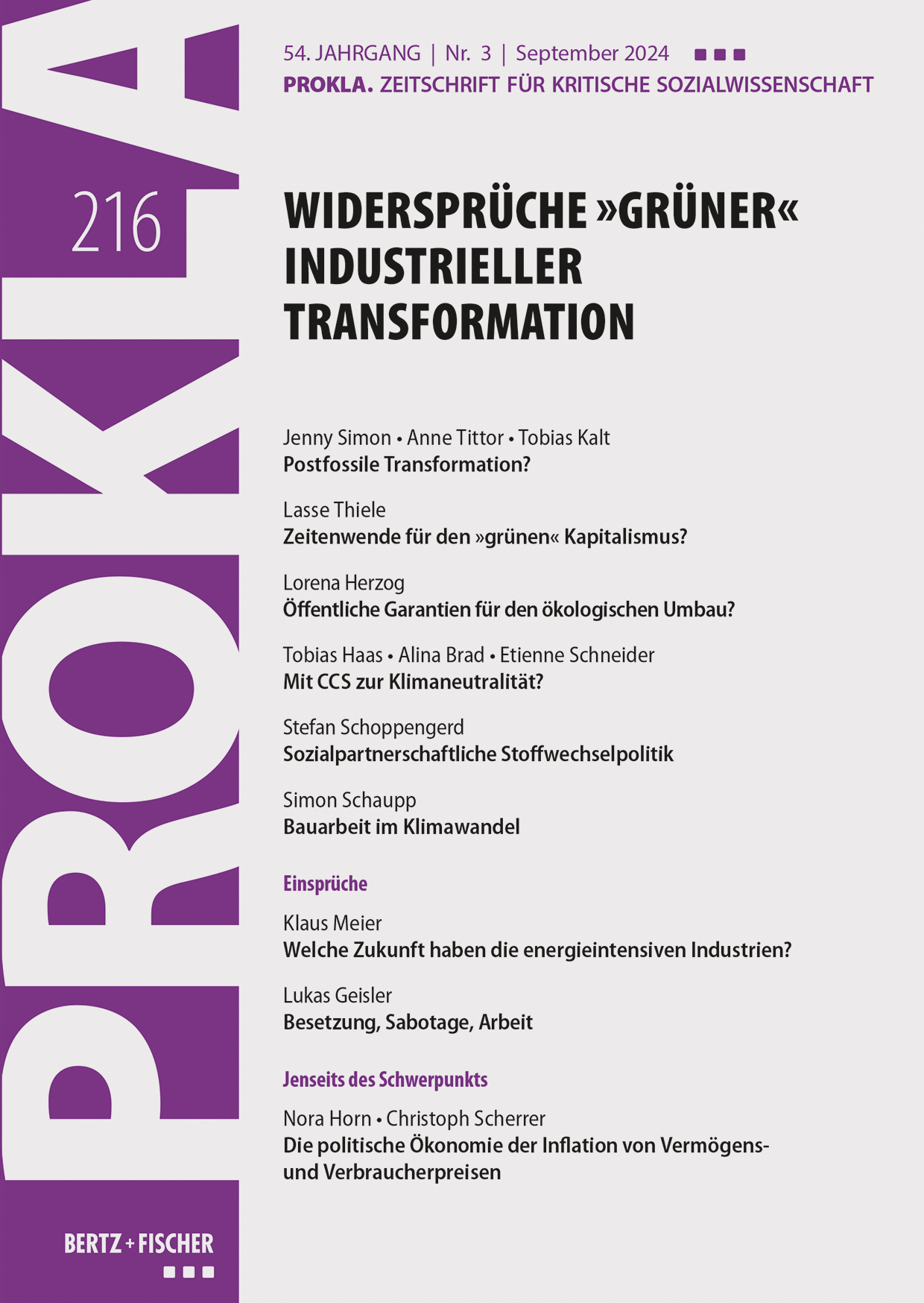What Future Do the Energy-Intensive Industries Have?
DOI:
https://doi.org/10.32387/prokla.v54i216.2130Keywords:
Cement Production, Chemical Industry, Decarbonization, Relocation of Production, Steel IndustryAbstract
The steel, chemical and cement industries are the sectors with the highest energy consumption and greenhouse gas emissions in Germany. They state that they want to produce climate-neutrally in the future. Estimates show that Germany will not produce enough green electricity and green hydrogen for a decarbonised industry. Hydrogen imports are technically difficult and expensive. Cheap solar and wind power from countries in the Global South could also lead to production relocations. In contrast to this scenario, the article focuses on a degrowth approach in which the ecologically transformed industrial core remains within the country.
Downloads
References
Acatech (Deutsche Akademie der Technikwissenschaften) & DECHEMA (2022): Fact Sheet Wasserstoff im Stahlsektor. URL: https://www.wasserstoff-kompass.de/fileadmin/user_upload/img/news-und-media/dokumente/Fact_sheet_Stahl.pdf, Zugriff: 9.7.2024.
Alvarez & Marsal (2024): Green Hydrogen: India’s Opportunity for a larger share in the Global Energy Trade. URL: https://www.alvarezandmarsal.com/printpdf/69091--en, Zugriff: 9.7.2024.
Biber-Freudenberger, Lisa (2023): Biomasse: Eine begrenzte Ressource. In: Spektrum der Wissenschaft 12/2023: 40-45.
BMWi (Bundesministerium für Wirtschaft und Energie) (2021): Langfristszenarien und Strategien für den Ausbau der Erneuerbaren Energiesystems in Deutschland. URL: https://langfristszenarien.de/enertile-explorer-wAssets/docs/LFS_Kurzbericht_final_v5.pdf, Zugriff: 9.7.2024.
Bossel, Ulf (2010): Wasserstoff löst keine Energieprobleme. LIFIS ONLINE. URL: https://www.leibniz-institut.de/archiv/bossel_16_12_10.pdf, Zugriff: 9.7.2024.
Cabernard, Livia u. a. (2022): Growing environmental footprint of plastics driven by coal combustion. In: Nature Sustainability 5: 139-148. DOI: https://doi.org/10.1038/s41893-021-00807-2. DOI: https://doi.org/10.1038/s41893-021-00807-2
DECHEMA (Gesellschaft für Chemische Technik und Biotechnologie) (2024): GreeN-H2 Namibia. Green Hydrogen Production in Namibia. Frankfurt/M. URL: https://dechema.de/green_hydrogen_namibia_report/_/H2-Report_GreeN-H2_digital.pdf, Zugriff: 9.7.2024.
Faraca, Giorgia / Astrup, Thomas (2019): Plastic waste from recycling centres: Characterisation and evaluation of plastic recyclability. In: Waste Management 95: 388-398. DOI: https://doi.org/10.1016/j.wasman.2019.06.038. DOI: https://doi.org/10.1016/j.wasman.2019.06.038
IEA (International Energy Agency) (2021): Ammonia Technology Roadmap. Towards more sustainable nitrogen fertiliser production. URL: https://iea.blob.core.windows.net/assets/6ee41bb9-8e81-4b64-8701-2acc064ff6e4/AmmoniaTechnologyRoadmap.pdf, Zugriff: 9.7.2024. DOI: https://doi.org/10.1787/f6daa4a0-en
IRENA (International Renewable Energy Agency) / AEA (Ammonia Energy Association) (2022): Innovation Outlook: Renewable Ammonia. Abu Dhabi/Brooklyn. URL: https://www.irena.org/-/media/Files/IRENA/Agency/Publication/2022/May/IRENA_Innovation_Outlook_Ammonia_2022.pdf, Zugriff: 9.7.2024.
Keramidas, Kimon u.a. (2022): Global Energy and Climate Outlook 2022. Energy trade in a decarbonised world. In: Publications Office of the European Union. Luxembourg. DOI: https://doi.org/10.2760/863694.
Luderer u.a.: (2021): Deutschland auf dem Weg zur Klimaneutralität 2045 - Szenarien und Pfade im Modellvergleich (Ariadne-Report). In: Potsdam Institute for Climate Impact Research. DOI: https://doi.org/10.48485/pik.2021.006.
Ozkan, Mihrimah u. a. (2022): Current status and pillars of direct air capture technologies. In: iScience 25(4): 103990. DOI: https://doi.org/10.1016/j.isci.2022.103990. DOI: https://doi.org/10.1016/j.isci.2022.103990
Prognos / Öko-Institut / Wuppertal-Institut (2020): Klimaneutrales Deutschland. Studie im Auftrag von Agora Energiewende, Agora Verkehrswende und Stiftung Klimaneutralität. URL: https://static.agora-energiewende.de/fileadmin/Projekte/2020/2020_10_KNDE/A-EW_195_KNDE_WEB.pdf, Zugriff: 9.7.2024.
Royer, Sarah-Jeanne u. a. (2018): Production of methane and ethylene from plastic in the environment. In: PLoS ONE 13(8): e0200574. DOI: https://doi.org/10.1371/journal.pone.0200574. DOI: https://doi.org/10.1371/journal.pone.0200574
Tatsutani, Marika u. a. (2023): Techno-economic Realities of Long-Distance Hydrogen Transport. URL: https://cdn.catf.us/wp-content/uploads/2023/09/25153519/catf-kbr-hydrogen-transport.pdf, Zugriff: 9.7.2024.
Toktarova, Alla u.a. (2022): Thermochemical recycling of plastics – Modeling the implications for the electricity system. In: Journal of Cleaner Production 374: 133891. DOI: https://doi.org/10.1016/j.jclepro.2022.133891. DOI: https://doi.org/10.1016/j.jclepro.2022.133891
Umweltbundesamt (2022): Kurzeinschätzung von Ammoniak als Energieträger und Transportmedium für Wasserstoff (28. Februar 2022). URL: https://www.umweltbundesamt.de/sites/default/files/medien/479/dokumente/uba_kurzeinschaetzung_von_ammoniak_als_energietraeger_und_transportmedium_fuer_wasserstoff.pdf, Zugriff: 9.7.2024.
VCI (Verband der Chemischen Industrie) (2019): Roadmap Chemie 2050. URL: https://www.vci.de/vci/downloads-vci/publikation/2019-10-09-studie-roadmap-chemie-2050-treibhausgasneutralitaet.pdf, Zugriff: 9.7.2024.
– (2023): Chemistry 4 Climate. URL: https://www.vci.de/vci/downloads-vci/publikation/broschueren-und-faltblaetter/final-c4c-broschure-langfassung.pdf, Zugriff: 9.7.2024.
VDZ (Verein Deutscher Zementwerke) (2020): Dekarbonisierung von Zement und Beton – Minderungspfade und Handlungsstrategien. Düsseldorf. URL: https://www.vdz-online.de/fileadmin/wissensportal/publikationen/zementindustrie/VDZ-Studie_Dekarbonisierung_Zement_Beton_2020.pdf, Zugriff: 9.7.2024.
Verpoort, Philipp C. u. a. (2024): Impact of global heterogeneity of renewable-energy supply on heavy industrial production and green value chains. In: Nature Energy 9: 491-503. DOI: https://doi.org/10.1038/s41560-024-01492-z. DOI: https://doi.org/10.1038/s41560-024-01492-z






